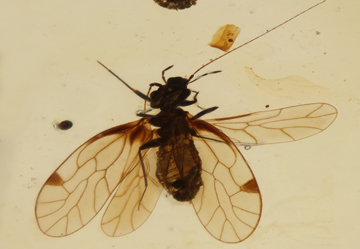Abstract
The new ‘suborder’ Cephalozygoptera was recently proposed for three fossil families of damselfly-like Odonata, on the basis of three characters of the head. Here we show, thanks to counter-examples of the presence of these characters in compression fossils of genuine Zygoptera, that these ‘characters’ do not exist in reality but are due to deformations and compression of the heads, a very frequent phenomenon in the fossil record of the whole superorder Odonatoptera. Furthermore, these alleged characters would have to have been regarded as symplesiomorphies, insufficient to support a new clade. Consequently, we consider the Cephalozygoptera as unfounded, to be rejected in the current state of knowledge. A new phylogenetic analysis of the whole clade Panodonata would be welcome. We also discuss the position of some previously described fossils: the Paleocene genus Valerea is restored in the Epallagidae (Euphaeidae), and the two Burmese amber genera Electrodysagrion and Palaeodysagrion are restored in the family Dysagrionidae.
References
Archibald, S.B., Cannings, R.A., Erickson, R.J., Bybee, S.M. & Mathewes, R.W. (2021) The Cephalozygoptera, a new, extinct suborder of Odonata with new taxa from the early Eocene Okanagan Highlands, western North America. Zootaxa, 4934 (1), 1–133.
https://doi.org/10.11646/zootaxa.4934.1.1
Bechly, G. (1996) Morphologische Untersuchungen am Flügelgeäder der rezenten Libellen und deren Stammgruppenvertreter (Insecta; Pterygota; Odonata), unter besonderer Berücksichtigung der Phylogenetischen, Systematik und des Grundplanes der Odonata. Petalura, Böblingen, Special Volume 2, 402 pp.
Bechly, G. (2007) Phylogenetic systematics of Odonata. Homepage on the Internet at: https://bechly.lima-city.de/system.htm (accessed 27 March 2021).
Bechly, G., Brauckmann, C., Zessin, W. & Gröning, E. (2001) New results concerning the morphology of the most ancient dragonflies (Insecta: Odonatoptera) from the Namurian of Hagen-Vorhalle (Germany). Zeitschrift für Zoologische Systematik und Evolutionsforschung, 39, 209–226.
https://doi.org/10.1046/j.1439-0469.2001.00165.x
Bechly, G., Garrouste, R., Aase, A., Karr, J.A., Grande, L. & Nel, A. (2020) The damselfly palaeofauna from the Eocene of Wyoming and Colorado, USA (Insecta, Odonata, Zygoptera). Papers in Palaeontology.
https://doi.org/10.1002/spp2.1346
Brauckmann, C. & Zessin, W. (1989) Neue Meganeuridae aus dem Namurium von Hagen-Vorhalle (BDR) und die Phylogenie des Meganisoptera. Deutsche Entomologische Zeitschrift, (N.F.), 36, 177–215.
https://doi.org/10.1002/mmnd.4810360127
Bybee, S.M., Kalkman, V.J., Erickson, R.J., Frandsen, P.B., Breinholt, J.W., Suvorov, A., Dijkstra, K.-D.B., Cordero-Rivera, A., Skevington, J.H., Abbott, J.C., Herrera, M.S., Lemmon, A.R., Lemmon, E.M. & Ware, J.L. (2021) Phylogeny and classification of Odonata using targeted genomics. Molecular Phylogenetics and Evolution, 160 (107115), 1–15.
https://doi.org/10.1016/j.ympev.2021.107115
Cockerell, T.D.A. (1908) Fossil insects from Florissant, Colorado. Bulletin of the American Museum of Natural History, 24, 59–69.
Dijkstra, K.-D.B., Kalkman, V.J., Dow, R.A., Stokvis, F.R. & Van Tol, J. (2014) Redefining the damselfly families: a comprehensive molecular phylogeny of Zygoptera (Odonata). Systematic Entomology, 39, 68–96.
https://doi.org/10.1111/syen.12035
Fleck, G., Bechly, G., Martínez-Delclòs, X., Jarzembowski, E.A. & Nel, A. (2004) A revision of the Mesozoic dragonfly family Tarsophlebiidae, with a discussion on the phylogenetic positions of the Tarsophlebiidae and Sieblosiidae (Odonatoptera: Panodonata). Geodiversitas, 26, 33–60.
Garrison, R.W., Ellenrieder, N. von & Louton, J.A. (2010) Damselfly genera of the New World. An illustrated and annotated key to the Zygoptera. The John Hopkins University Press, Baltimore, xiv + 490 pp.
Garrouste, R. & Nel, A. (2015) New Eocene damselflies and first Cenozoic damsel-dragonfly of the isophlebiopteran lineage (Insecta: Odonata). Zootaxa, 4028 (3), 354–366.
https://doi.org/10.11646/zootaxa.4028.3.2
Garrouste, R., Wedmann, S., Pouillon, J.-M. & Nel, A. (2017) The oldest ‘amphipterygid’ damselfly of tropical affinities in the Paleocene of Menat (Zygoptera: Eucaloptera). Historical Biology, 29, 818–821.
https://doi.org/10.1080/08912963.2016.1247448
Handlirsch, A. (1906–1908) Die fossilen Insekten und die Phylogenie der rezenten Formen. Ein Handbuch für Paläontologen und Zoologen. W. Engelmann., Leipzig, ix + 1430 pp.
Jacquelin, L., Desutter-Grandcolas, L., Chintauan-Marquier, I., Boistel, R., Zheng, D., Prokop, J. & Nel, A. (2018) New insights on basivenal sclerites using 3D tools and homology of wing veins in Odonatoptera (Insecta). Scientific Reports, 8 (238), 1–7.
https://doi.org/10.1038/s41598-017-18615-0
Nel, A., Bechly, G., Prokop, J., Béthoux, O. & Fleck, G. (2012) Systematics and evolution of Paleozoic and Mesozoic damselfly-like Odonatoptera of the ‘Protozygopteran’ grade. Journal of Paleontology, 86, 81–104.
https://doi.org/10.1666/11-020.1
Nel, A., Martínez-Delclòs, X., Paicheler, J.-C. & Henrotay, M. (1993) Les ‘Anisozygoptera’ fossiles. Phylogénie et classification (Odonata). Martinia, Numéro Hors Série, 3, 1–311.
Nel, A. & Papazian, M. (1985) Description d’une nouvelle espèce fossile de Lestes Leach, 1815, du Stampien de Céreste (Alpes-de-Haute-Provence) (Odon. Lestidae). Entomologica Gallica, 1, 275–279.
Nel, A., Petrulevičius, J.F., Gentilini, G. & Martínez-Delclòs, X. (2005) Phylogenetic analysis of the Cenozoic family Sieblosiidae (Insecta: Odonata), with description of new taxa from Russia, Italy and France. Geobios, 38, 219–233.
https://doi.org/10.1016/j.geobios.2003.10.007
Nel, A., Poschmann, M.J. & Wedmann, S. (2020) New dragonflies and damselflies (Odonata) from the late Oligocene of Enspel (Rhineland-Palatinate, SW Germany). Palaeontologia Electronica, 23 (3) (a59), 1–24.
Nel, A., Prokop, J., Pecharová, M., Engel, M.S. & Garrouste, R. (2018) Palaeozoic giant dragonflies were hawker predators. Scientific Reports, 8 (12141), 1–5.
https://doi.org/10.1038/s41598-018-30629-w
Rasnitsyn, A.P. & Pritykina, L.N. (2002) 2.2.1.1.2. Superorder Libellulidea Laicharting, 1781. Order Odonata Fabricius, 1792. The dragonflies. pp. 97–104. In: Rasnitsyn, A.P. & Quicke, D.L.J. (Eds), History of insects. Kluwer Academic Publishers, Dordrecht, Boston, London, xi + 517 pp.
Rehn, A.C. (2003) Phylogenetic analysis of higher-level relationships of Odonata. Systematic Entomology, 28, 181–239.
https://doi.org/10.1046/j.1365-3113.2003.00210.x
Riek, E.F. & Kukalová-Peck, J. (1984) A new interpretation of dragonfly wing venation based upon Early Carboniferous fossils from Argentina (Insecta: Odonatoidea) and basic characters states in pterygote wings. Canadian Journal of Zoology, 62, 1150–1166.
https://doi.org/10.1139/z84-166
Théobald, N. (1937) Les insectes fossiles des terrains oligocènes de France. Bulletin Mensuel (Mémoires) de la Société des Sciences de Nancy, 1, 1–473.
Tillyard, R.J. (1917) The biology of dragonflies (Odonata or Paraneuroptera). Cambridge University Press, London, xii + 396 pp.
https://doi.org/10.5962/bhl.title.35170
Zheng, D., Zhang, Q., Nel, A., Jarzembowski, E.A., Zhou Z., Chang, S.-C. & Wang, B. (2017) New damselflies (Odonata: Zygoptera: Hemiphlebiidae, Dysagrionidae) from mid-Cretaceous Burmese amber. Alcheringa, 41, 12–21.
https://doi.org/10.1080/03115518.2016.1164402
Zheng, D., Chang, S.C. & Wang, B. (2018) A new dysagrionid damselfly (Odonata: Zygoptera: Palaeodysagrion) from mid-Cretaceous Burmese amber. Alcheringa, 42, 300–304.
https://doi.org/10.1080/03115518.2017.1381991
Zheng, D., Zhang, H., Jarzembowski, E.A. & Wang, B. (2019) Electrodysagrion neli sp. nov., the second Cretaceous dysagrionine damselfly (Odonata: Zygoptera: Dysagrionidae) from Kachin amber, northern Myanmar. Palaeoentomology, 2 (6), 556–559.


